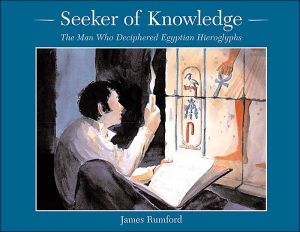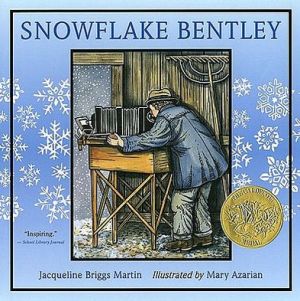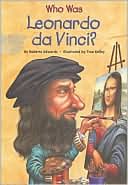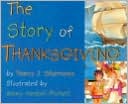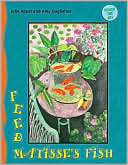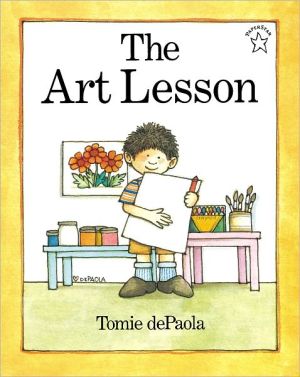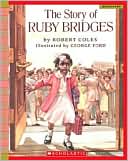Seeker of Knowledge: The Man Who Deciphered Egyptian Hieroglyphs
To a child, the future is a magnificent dream. For Jean-Francois Champollion, the dream was to sail up the Nile in Egypt and uncover the secrets of the past. In 1802, when Champollion was eleven years old, he vowed to be the first person to read Egypt's ancient hieroglyphs. He faced great challenges over the next twenty years as he searched for the elusive key to the mysterious writing—and the fulfillment of his dreams.\ \ \ A biography of the French scholar whose...
Search in google:
To a child, the future is a magnificent dream. For Jean-Francois Champollion, the dream was to sail up the Nile in Egypt and uncover the secrets of the past. In 1802, when Champollion was eleven years old, he vowed to be the first person to read Egypt's ancient hieroglyphs. He faced great challenges over the next twenty years as he searched for the elusive key to the mysterious writing -- and the fulfillment of his dreams.Publishers WeeklyA tale of heroic perseverance and discovery, Rumford's (The Cloudmakers) picture book biography of Jean-Fran ois Champollion, the early-19th-century amateur scholar who first deciphered hieroglyphs, will fire the imagination. Elegant watercolors offer pivotal views of the determined young Frenchman, from his initial boyhood interest in Egypt through the years of solo study while teaching school in Grenoble, to his meeting with Napoleon, with whom he shared a passion for Egypt ("Napoleon dreamed of glory. Jean-Fran ois dreamed of discovery"), his eventual breakthrough in 1822 and, finally, his expedition up the Nile. As adept with his pen as he is with his watercolor brush, Rumford etches his lucid prose with lyrical descriptions ("The rushing sound of the pharaoh's name, as if carried on wings across the centuries, filled the room"). Occasional hieroglyphs (suggesting "meet," "sailed," "dog," "celebrated" and so on) are inserted in the text but are too simplistic to intrigue readers. Much more effectively, the margins are peppered with examples of Egyptian words and their hidden meanings: "There is a long-necked, far-seeing giraffe in `predict,' " for instance, and "There are strongly woven sandals firmly planted on the ground in `never give up.' " An afterword provides further information, and a chart of a couple dozen hieroglyphic words offers a glimpse of the translation process. Ages 5-9. (Apr.) Copyright 2000 Cahners Business Information.\|
\ Publishers Weekly"A tale of heroic perseverance and discovery, this picture book biography of Jean-Francois Champollion, the early-19th-century amateur scholar who first deciphered hieroglyphs, will fire the imagination," said PW. Ages 5-8. (June) Copyright 2003 Reed Business Information.\ \ \ \ \ Publishers Weekly - Publisher's Weekly\ A tale of heroic perseverance and discovery, Rumford's (The Cloudmakers) picture book biography of Jean-Fran ois Champollion, the early-19th-century amateur scholar who first deciphered hieroglyphs, will fire the imagination. Elegant watercolors offer pivotal views of the determined young Frenchman, from his initial boyhood interest in Egypt through the years of solo study while teaching school in Grenoble, to his meeting with Napoleon, with whom he shared a passion for Egypt ("Napoleon dreamed of glory. Jean-Fran ois dreamed of discovery"), his eventual breakthrough in 1822 and, finally, his expedition up the Nile. As adept with his pen as he is with his watercolor brush, Rumford etches his lucid prose with lyrical descriptions ("The rushing sound of the pharaoh's name, as if carried on wings across the centuries, filled the room"). Occasional hieroglyphs (suggesting "meet," "sailed," "dog," "celebrated" and so on) are inserted in the text but are too simplistic to intrigue readers. Much more effectively, the margins are peppered with examples of Egyptian words and their hidden meanings: "There is a long-necked, far-seeing giraffe in `predict,' " for instance, and "There are strongly woven sandals firmly planted on the ground in `never give up.' " An afterword provides further information, and a chart of a couple dozen hieroglyphic words offers a glimpse of the translation process. Ages 5-9. (Apr.) Copyright 2000 Cahners Business Information.\|\ \ \ Children's LiteratureAn introduction to Jean-Francois Champillion, the French scholar who provided the first clues to unlocking the mystery of the Rosetta Stone serves also as a fine introduction to Egyptology. Rumford faces each page of text with illustrations of Champillion from his childhood interest in hierglphys through his near-disastrous talk with Napoleon to his triumphant linking of a cartouche which encircled the name of the Egyptian god of writing. By including glyphs in the text as well as round it, Rumford involves young readers in the complicated meaning of hieroglyphs which may represent letters, or sounds, or nuance. For instance, double sandals planted firmly on the ground represent "never give up" while a cane shape represents the letter "s." Back matter gives further information and a box gives a sample of how one might translate some hieroglyphs. For a much younger audience than Carol Donoughue's excellent The Mystery of the Hieroglyphs (Oxford 1999), this book is especially well-suited for classroom use in the middle elementary grades studying Egyptian civilization. 2000, Houghton Mifflin, Ages 8 to 11, $15.00. Reviewer: Susan Hepler—Children's Literature\ \ \ \ \ Children's LiteratureJean-Francois Champollion was one of those boys who had a dream and he was also one of those boys who got to live his dream. Jean decided when he was only seven that he was going to go to Egypt, like the great Napoleon Bonaparte. Soon after this time, Jean began to develop a real interest in the history of ancient Egypt. He learned that no one could understand the strange and cryptic writing that the ancient Egyptians had left behind. Napoleon had brought a stone (called the Rosetta stone) covered with Greek and Egyptian script back from Egypt. Scholars studied and studied it, hoping the stone would help them understand how to translate Ancient Greek, which they could understand, into Ancient Egyptian, which they could not. Nothing seemed to work, however. With great skill James Rumford leads us down the rocky path of discovery, showing us how Jean-Francois Champollion was finally able to understand what the hieroglyph symbols meant. Peppered throughout the text and on each page of text the reader will find hieroglyphs along with their translations. Luminescent watercolor illustrations carry us into the great adventure that was Jean's short but remarkable life. At the back of the book the reader will find further information about the breaking of the hieroglyph code and Jean-Francois Champollion incredible life. In addition, there is a page about hieroglyphs, their meanings and pronunciation. Finally, in closing, the author reminds us that perusing our dreams can be the most rewarding thing that we ever do. A unique book which describes not just a man's achievements but also the true joy that one experiences when one discovers that metaphorical and illusive pot of gold at the end of therainbow. 2000, Houghton Mifflin Company, \ — Marya Jansen-Gruber\ \ \ \ \ School Library JournalGr 2-5-This picture-book biography tells the intriguing story of the man who deciphered Egyptian hieroglyphs. As a child, Jean-Fran ois Champollion learned that no one could read Egyptian writing and determined that he would be the one to do so. By age 16, he had learned all the known ancient languages and was eager to work with scholars who were attempting to translate the hieroglyphs with the help of the Rosetta Stone. Though they turned him down, he doggedly pursued his passion on his own and at age 30, had a sudden breakthrough. While studying the name of a Pharaoh copied from a temple wall, he discovered that the characters were not just related to meaning, but also to sounds. Though the key to unlocking the secret may not be completely clear to children, Champollion's fascination with hieroglyphs and the realization of his dream will capture their interest and perhaps whet their curiosity for further study. Framed watercolor paintings done in soft blues, purples, and sunlit pinks evoke a sense of mystery compatible with the suspense of the scholar's discovery process. Small hieroglyphs are embedded in the text. Those with less-obvious meanings seem distracting at first reading. More effective are the larger, captioned ones in the margins that make the picture-meaning connection clear ("There is a long-necked, far-seeing giraffe in `predict'"). Overall, an engaging introduction to a timeless topic.-Adele Greenlee, Bethel College, St. Paul, MN Copyright 2000 Cahners Business Information.\|\ \
